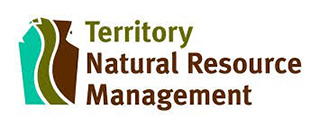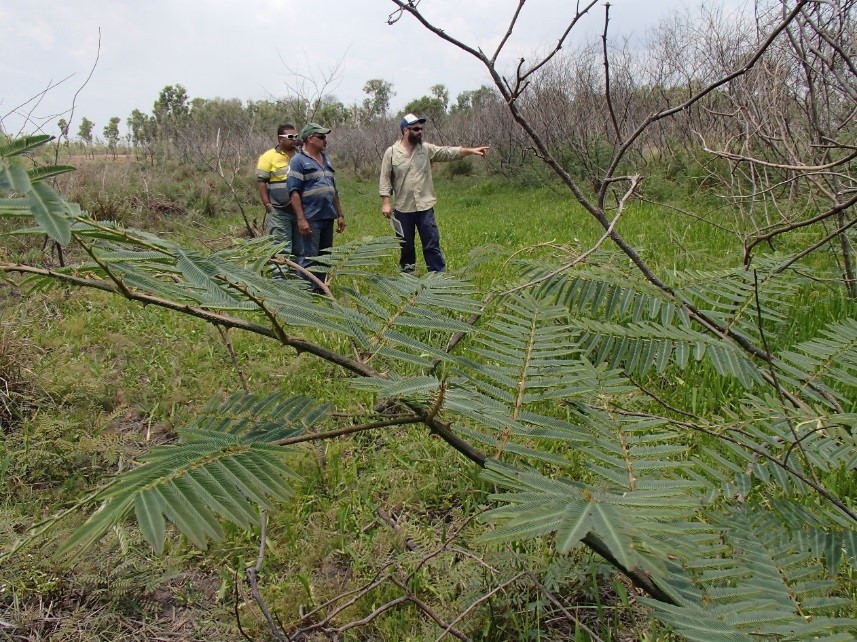Mimosa management in the Finniss area
Susanne Casanova
(Western Top End Coordinator, Territory Natural Resource Management).
An aerial view of the Finniss area floodplains, one year after spraying for Mimosa pigra
Top End floodplain pastoral properties have been under threat from Mimosa pigra for many years. Mimosa seeds are water-borne and can reach floodplains from sources further upstream on drainage lines and billabongs. As floodplain waters recede at the start of dry season each year, germinating seedlings become adult plants within a year, forming impenetrable thickets that produce huge banks of long-lived seeds. Seeds on the surface may germinate within a few months, but in addition, there are seeds which become buried in soil or leaf litter, and these may persist for twenty years or more, only germinating when the soil is disturbed.
In the Finniss and Reynolds River catchments the weed causes many land management problems, including reducing the grazing value of pastoral land by blocking the access of stock to pasture
An aerial view of the Finniss area floodplains, one year after spraying for Mimosa pigra
Steered by Territory Natural Resource Management, the Finniss Reynolds Catchment Group (FRCG) project has been operating since 2012, to address the problem of mimosa across the catchment. The project has engaged land managers and representatives from pastoral properties, Indigenous rangers and the Northern Land Council, Weeds Management Branch, Litchfield National Park, NT Land Corporation and various small properties, in order to share knowledge and resources and improve land management at catchment scale.
Funds for the project have come from the Federal Government’s Biodiversity Round 1 Fund (2012-2017), the National Landcare Program, and most recently, contributions have been received from the Ichthys LNG Project and the Community Benefit Fund. Activities undertaken to date include collection of baseline data on feral pig density and aerial culling to achieve a 70% reduction in targeted pig populations, mapping of mimosa infestation in the catchment, increased establishment of biocontrol agents, fauna surveys to identify priority fauna species in the area, and annual aerial spray programs to treat large scale infestations of mimosa each wet season.
The mimosa aerial spray program has been a huge investment, with approximately $700,000 of Australian Government funding matched dollar for dollar by the pastoral properties in the catchment, between 2013 and 2017. Where properties have participated, it has taken between three and five years to see a reduction in the amount of treatment needed in a given paddock. Expenditure of around $90 per hectare has been needed over five years to ‘reclaim’ areas from thick mimosa, which equates to a floodplain pasture protection value of around $20/hectare. Whilst treated floodplain areas continue to need ongoing annual investment to address the soil seed bank, this treatment is at a much lesser cost than the initial investment.
The group structure of the project has been an important aspect in increasing relationships and knowledge transfer between the people managing land in the catchment. A Technical Advisory Group was used in the early stages of the project, to help guide best practice weed management in the catchment and buffer against knowledge losses occurring through management staff turnover on properties.
Colin Deveraux has many years of experience with mimosa management in the Finniss area, starting on a small property on the north side of the river and transferring his knowledge from here to Twin Hill station on the broader Finniss floodplain, and to the Biodiversity Fund project. Colin emphasises the point that successful treatment is all about timing. Aerial spray needs to occur when plants are actively growing but before flowering and seed set. Ideally, this is at the beginning of the wet season, after some rain has helped new seedlings germinate and grow up high enough that they’re easy for the spray pilots to see in the pasture.
However, every wet season is different, and some years there is only a small window to get the treatments carried out with optimal timing. If you go too early, the new plants coming up can get missed, and then go a whole season and make seed before the pilot comes by again. On the other hand, you also don’t want to be spraying at the last minute with the floodwaters lapping around because plants in standing water don’t die well. It is critical to perform treatments annually and never skip a year. It’s also very important to keep an eye out for mimosa plants which don’t die despite being sprayed, and treat these with alternate herbicides.
While all properties have their own priority areas and works programs, overall the key ingredients to successful mimosa treatment have been annual follow up prior to flowering, prevention of soil disturbance, and retention of good grass cover, including by introduced pasture species such as Olive hymenachne. On Twin Hill Station persistence has paid off, with treatment of all old growth mimosa now completed after an extensive twenty-year-long treatment program, and at nearby Labelle Downs and Welltree stations, aerial spray is being used to successfully keep central floodplain paddocks clear and push mimosa back upstream along the Reynolds River. On Finniss River Station, floodplains continue to remain clear, with treatments focussed on mimosa pockets under paperbarks, and on Tipperary station, focus is on treating all plants in the upper most parts of the Reynolds catchment, to reduce seeds coming down the river to Litchfield Station on the floodplain below.
To learn more about the Finniss Reynolds Catchment Group, visit the Mimosa pigra catchment plan page on the Territory Natural Resource Management website or contact Susanne Casanova at Territory Natural Resource Management. or 0438 765 979.
Territory Natural Resource Management (TNRM) is an independent not for profit organisation that works with landholders, community groups, industry and government to ensure sustainable management of our water, land, soils, plants and animals. If you have an NRM related research project or story that you would like to share at this year’s TNRM conference (13th-15th November 2018), please visit the abstract submission page.


Give feedback about this page.
Share this page:
URL copied!

